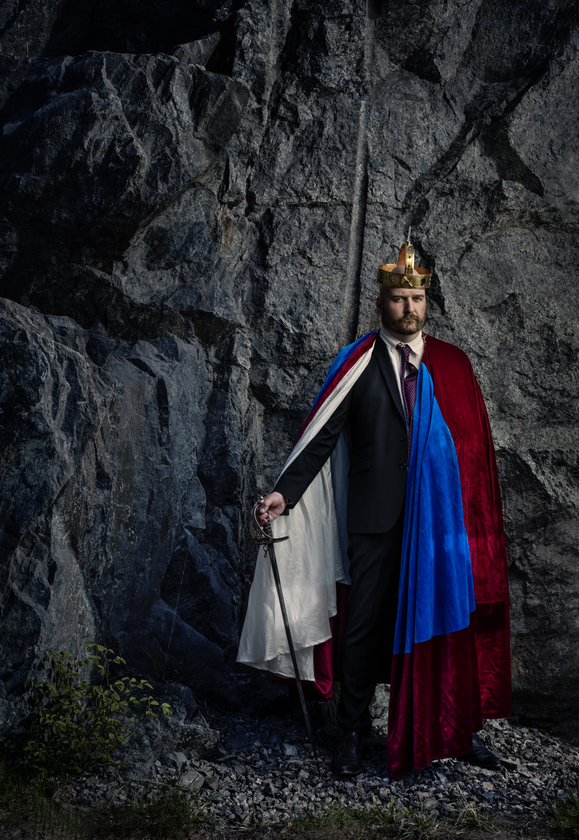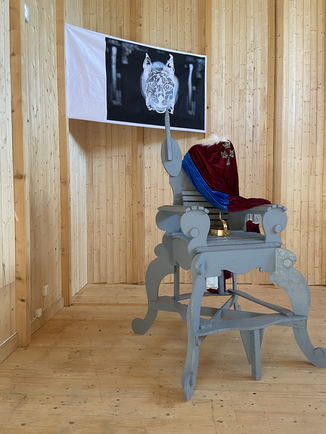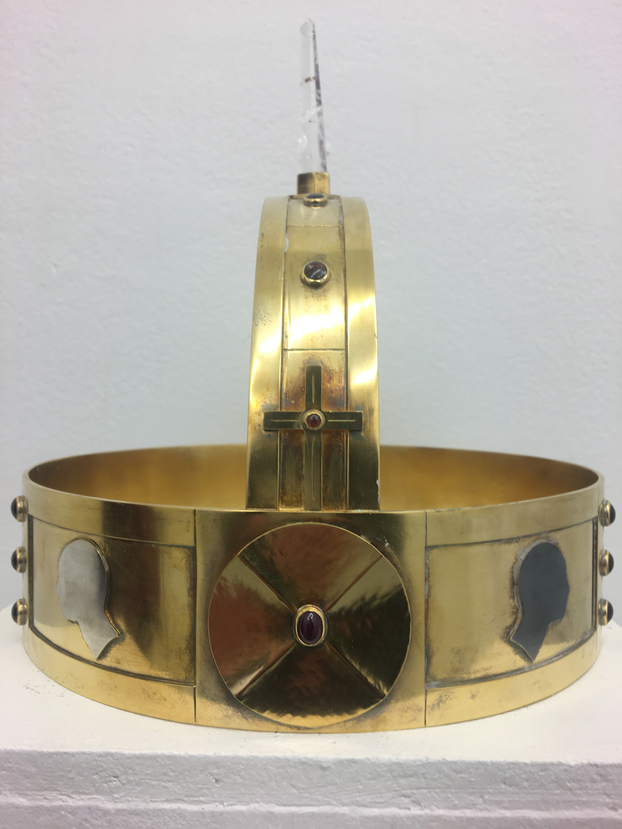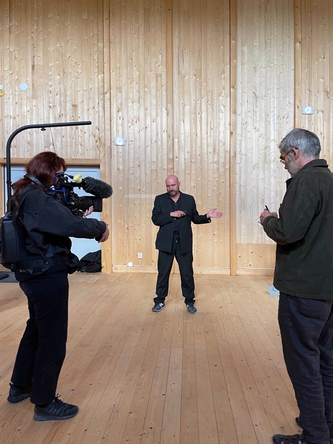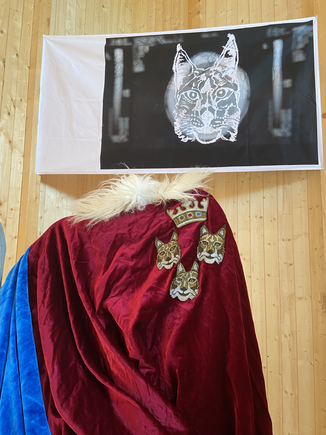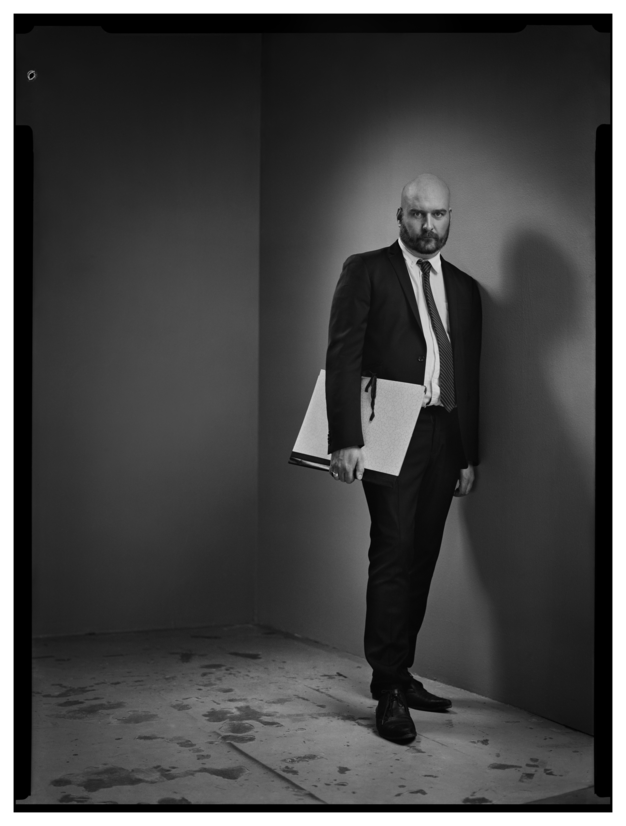Det är som att de starka upplevelserna sätter sig i kroppen och minnet på ett djupare plan, detta kan sedan överföras omedvetet till ett konstverk eller projekt, det skiner i genom som en klangbotten. Minnesteknik eller mnemonik har därför intresserat mig som konstnär sedan länge. Det är något med det visuella runt minnestekniken, föremålen placerade i rummet, som påminner om det rumsliga uttrycket när man skapar en utställning.
Redan under antiken omges minnestekniken av ett slags esoteriskt skimmer men det är under medeltiden som den intar närmast en magisk funktion. Den som har tillgång till språket har tillgång till Guds ord, den som kan bevara denna information i minnet har på så vis en hemlig nyckel till det gudomliga
Den utveckling av minnestekniken som man under denna tid använder sig av ser ut som en spiral, till en början utformad för att missionärer skulle kunna memorera Bibeln, men det används också flitigt bland poeter. Dantes ”Inferno” är utformad som en spiral som en referens just till denna minneskarta.
Arkivet över min pappas fiktiva kungarike Roma ligger på mitt ateljégolv, runtomkring på borden och i hörnen. Han ägnade sig åt detta rike från att han var tio till sin död, nästan 60 år gammal. Små samlingar av saker, allt pågick i hans huvud och nu har det pågått i mitt huvud och flyttats runt i detta rum, jag försöker läsa och förstå hur det funkar, vad som utgör detta auktoritära kungadöme vad är det som binder sakerna till en samling, men framför allt fins där ledtrådar till vem min pappa var.
Minnet, tiden eller historien och blodet, vad utgör en samling, hur förvandlas något från några lösa föremål till en samling. Samma sak med det tillhörande kungariket eller nationen, hur blir det till? Detta har var min frågeställning under arbetet med det här konstprojektet
Den här lägenheten fylld av artefakter från från familjen, från en svunnen tid, ett museum över människor som sedan länge är döda men fortfarande fins där. En karta över en begränsad yta som en nation byggt av samlingar av dessa människor, deras gärningar, identitet och blodsband som binder de, samman till en samling samma ingredienser är ju också en nation
BLODET, GRÄNSEN, ARKIVET
Jag går genom den lägenhet som tillhörde min pappa på Krukmakargatan. I mitt huvud jag visualiserar platsen som en slags känslomässig övning eller som mental förberedelse. Det fins en minnesteknik, mnemonik, som är grunden för upplägget, en minnesteknik använd sedan antiken, metoden är att visualisera en plats som man känner väl för att sedan i sitt huvud placera ut föremål på nyckelplatser i rummen. Byggnaden måste finnas i verkligheten och du behöver själv ha varit där och känna huset och rummen väl. Byggnaden representerar exempelvis texten som du vill memorera i sin helhet, varje rum i huset är som stycken där man placerar ut föremål som symboliserar olika nyckeldelar i texten som man sedan kan hänga upp minnet på. Jag gör det mer för att hitta en stämning eller utgångspunkt men också för att gå tillbaka för att förstå mig själv genom att återskapa minnet av det förflutna.
Det fins en anekdot från romartiden om hur mnemonik kom till. Poeten Simonides (556-468 f kr) anlitades för att framföra ett stycke lyrik för att hedra värden för en bankett, Scopio. Under läsningen gjorde poeten en slags traditionell avstickare där han lät en del av talet också vara en hyllning till tvillinggudarna Castor och Pollux. Efter att han utför sitt uppdrag lät värden honom förstå att han bara tänkte betala hälften av den avtalade summan, eftersom att poeten referat till tvillinggudarna kunde resterande av betalningen skänkas av dem. När festen pågått en stund kallades Simonides till ytterporten eftersom två unga män sökte honom. När han kom till porten var ingen där, men kort därefter kollapsade taket över festdeltagarna och alla utom poeten dödades. Resten av betalningen var alltså levererad, det vill säga livet i behåll.
Efter denna svåra tragedi ville de anhöriga begrava sina nära men eftersom att kropparna inte gick att identifiera därför att de var allt för illa tilltygade frågade man Simonides om han mindes ungefär hur gästerna suttit runt bordet. Enligt honom själv mindes han exakt var gästerna varit placerade på grund av den rumsliga minnesbilden av gästerna runt bordet. Han lär då ha dragit slutsatsen att om man kunde hänga upp minnet på en tydlig struktur kunde man minnas och ta in en stor mängd information, exempelvis text.
Det är en bra historia även, om man nu snarare tror att tekniken använts av människor långt mycket längre.
Jag visualiserar min vandring i genom tvårummaren byggd i början på 1980-talet. Luften i den här typen av lägenheter från den tiden blir kvav på ett särskilt sätt, det är som hur mycket man vädrar så är luften alltid för torr. Den typen av byggnader andas inte som äldre hus gör, det är för tätt, små fönster och kompakta väggar, det kommer inte in något syre och det som kommer in går inte runt. I vardagsrummets fönstret en tunn gardin och en hängande porslinsblomma, jag minns det som att den blommar en gång om året och att det var en stor sak. Ett vitrinskåp i hörnet som ursprungligen stått på en läkarmottagning. Skåpet är fullt av saker alla tycks ha en bakgrundshistoria, placerade utifrån vad som verkar som ett kaos men ändå med en mening, var sak på sin plats utan att det tillsynes finns ett mönster som kan ses med blotta ögat
Innehållet känns som ett kuriosakabinett, högt och lågt finns där: kritpipor fån sjuttonhundratalet, en kopia av Karl XIIs dödsmask, en liten pistol som nog har varit ett fullt fungerande vapen, en fake coca cola-burk med låtsasskum som jag har köpt till hans födelsedag på Buttricks skämtartikel-affär som fortfarande ligger på Drottninggatan och fortfarande känns den lovande när man kliver in, sedlar från Finland dess första trevande år efter inbördeskriget, en historisk skärningspunkt i världshistorien, allt souvenirer som liksom nästan får en att känna lukten eller skönja ljuset av en annan plats eller tid.
Jag går igenom köket, det stora ekskåpet i jugendstil i ljus ek, inuti det lager av porslin från olika tider i varierande funktionsgrad. Allt köpt av en generation för att tas fram vid finare tillfällen, det var bara det att varje ny generation köpte sin eget för tiden moderna servis men sparade den gamla, som leravlagringar är porslinet staplat
Genom köket till en korridor med prickiga tapeter som ser ut som färgstänk, standard från när huset är byggt, alla väggar fulla av bilder som en konstsalong från förra sekelskiftet. På några tunga bokhyllor sitter montrar med rakdon, klockor och mynt som i en privat samling, vilket är just vad det är, allt så väldigt trångt
Sovrummet som nu är ett bibliotek, böcker som doftar, långa rader av band, klassiskt fakta från filosofi och konsthistoria till matematik, konstböcker. poesi och några få men för litteraturhistorien viktiga romaner.
Jag har i mitt konstnärsskap intresserat mig för minnet, både det personliga och det kollektiva och vad det gör med oss. Detta har tagit olika former och i perioder upplever jag att starka händelser sätter sig på ett sublimt sätt och ligger där i bakgrunden av hela konstprocessen.
Poeten Rainer Maria Rilke beskriver det där fint tycker jag:
“And still it is not enough to have memories. One must be able to forget them when they are many, and one must have the great patience to wait until they come again. For it is not yet the memories themselves. Not until they have turned to blood within us, to glance, to gesture, nameless and no longer to be distinguished from ourselves – not until then can it happen that in a most rare hour the first word of a verse arises in their midst and goes forth from them.”
”The Notebooks of Malte Laurids Brigges ”)
På Krukmakargatan och på Årsta gamla skola där jag nu också jobbar med alla aspekter av dessa prylar, arkiv över ett landet vid någon annan horisont, historia som kommer från landet som aldrig funnits. Vem pysslar med micro nationer? Antagligen en konstnär, troligen en man, dess historia inte alldeles ovanlig.
Det finns olika sorters motiv och modeller, som det litterära Redonda som än i denna dag existerar men som på något sätt gått från i arv från person till person ofta kända författare.
Eller som det rike som står mig själv allra närmast, Elgaland Vargaland – en nation som utgörs av alla gränser, både rent fysiska gränsområden mellan nationer som ingen annan äger, konstens gränser och till och med dödens. Konstruktionen av detta blir en nation som både existerar och inte.
Somliga fantasiriken existerar i stort sätt bara i en mental värd av fantasi, andra har fysisk form kan till och med ha ambitionen att faktiskt existera som suverän stat.
”Some dreamers hope their new states will be the lands in which they can be (or might have been in some previous age) their own kings and queens and heroes, in which they can play with dreams of power and glory without fear of failure”
Willam Bryk The Ephemera of fictional states Cabinet issue 18 2005
I vår tid är gränser, blod och nation återigen laddat och farligt, vem som får vara innanför murarna och innanför gränserna. Medborgaren och den papperslösa, den som inte hör hemma och ska ut, fel på alla sätt, fel utseende, fel kultur. Helt fel helt enkelt, inte bara människa, det är en naiv tanke.
Det lilla rummet av kuriosa som ett kuriosakabinett, små lådor dolda fack, det går att leta sig fram för att om möjligt finna ledtrådar både till den slutna lilla värden och tvingas fundera över den större och där står jag nu och undrar om det inte dags att gå vidare.
När den självutnämnda Prins Heinrich XIII som en ledande gestalt i Reichsburger-rörelsen på fullaste allvar med hjälp av personer på olika positioner i det tyska samhället tänker sig att störta den tyska staten för att bygga en egen stat; en nostalgisk fantasi om en familjs storhetstid med gränser som de var dragna innan första världskriget. Det blir fiktion och verklighet, allt för påtagligt, jag blir illa berörd av min pappas auktoritära rike, det smakar illa i munnen. Det finns något så sorgligt att leken med världen ledde till denna längtan efter det auktoritära, militära och fyrkantiga.
Tillbaka i lägenheten på Krukmakargatan, i biblioteket bakom det stora ekskrivbordet står det svärd eller värjor av olika storlekar, en del antagligen antika andra replikor, på sidan sitter en bild av Gustav II Adolf, stormaktskungen. Skrivbordet och de tunga bokhyllorna i kombination med vapnen och porträttet gör det till samlingarnas högkvarter där allting skapas men också den plats varifrån makten och riksbyggandet ska utövas.
Under åren som jag vridit, vänt och experimenterat med det här kungariket har jag också lekt med maktsymboler. Inför det här kursen fick jag tidigt förslaget att bygga en tron. Jag började med att göra research där jag kontaktade det kungliga slottet i för att ta reda på hur en möjlig tron som jag kunde skapa skulle kunna se ut. Det visade sig att den svenska rikstronen är den som byggdes för drottning Kristinas kröning, Silvertronen, alltså dottern till Gustav den II Adolf, min pappas besynnerliga val av hjältebild på väggen i biblioteket. Efter att jag gjort ett skissarbete har jag med hjälp av konstnären Johan Wiking låta bygga en egen tron, på något sätt den ultimata maktsymbolen.
Jag känner mig mycket obekväm.
Jag tror att det är det sista leken med min pappas värld. Nu lämnar jag landet Roma och lägenheten på Krukmakargatan
Claudia Ranking, medborgare 2014
Frances A. Yates, The art of memory,1966
John Berger, Another way of Telling 1982
Juha Verto, Artistic Research What is it Who does it why 2018
Leif Elggren Carl Michael Von Hausswolf, The Kingdoms of Elgaland Vargaland 2016
Willam Bryk The Ephemera of fictional states Cabinet ISSUE 18,2005
Rainer Maria Rilke The Notebooks of Malte Laurids Brigge1910
THE BLOOD, THE BORDERS, THE ARCHIVE
I walk through the apartment that belonged to my father on Krukmakargatan. In my head I visualize the place as a kind of emotional exercise or as mental preparation. There is a memory technique, mnemonics, which is the basis of the layout, a memory technique used since ancient times, the method is to visualize a place that you know well and then place objects in your head at key locations in the rooms. The building must exist in reality and you need to have been there yourself and know the house and rooms well. For example, the building represents the text that you want to memorize in its entirety, each room in the house is like pieces where you place objects that symbolize different key parts of the text that you can then hang the memory on. I do it more to find a mood or starting point but also to go back to understand myself by recreating the memory of the past.
There is an anecdote from Roman times about how mnemonics came about. The poet Simonides (556-468 BC) was hired to perform a piece of poetry in honor of the host of a banquet, Scopio. During the reading, the poet made a kind of traditional digression where he let part of the speech also be a tribute to the twin gods Castor and Pollux. After he completes his task, the host gives him to understand that he intends to pay only half of the agreed sum, since if the poet refers to the twin gods, the rest of the payment could be bestowed by them. After the party had gone on for a while, Simonides was called to the outer gate because two young men were looking for him. When he got to the gate, no one was there, but shortly afterwards the roof collapsed on the partygoers, killing all but the poet. The rest of the payment was thus delivered, i.e. life preserved. After this difficult tragedy, the relatives wanted to bury their loved ones, but since the bodies could not be identified because they were too badly decomposed, Simonides was asked if he remembered roughly how the guests sat around the table. According to himself, he remembered exactly where the guests had been placed because of the spatial memory image of the guests around the table. He is said to have then concluded that if you could hang your memory on a clear structure, you could remember and take in a large amount of information, for example text. It's a good story even if you now rather believe that the technology has been used by humans for much, much longer.
I visualize my walk through the two-room house built in the early 1980s. The air in this type of apartment from that time gets stuffy in a special way, it's like no matter how much you ventilate, the air is always too dry. That type of building doesn't breathe like older houses do, it's too tight, small windows and compact walls, no oxygen gets in and what gets in doesn't go around. In the living room window a thin curtain and a hanging porcelain flower, I remember it as blooming once a year and it was a big deal. A display cabinet in the corner that was originally in a doctor's surgery. The closet is full of things, all of which seem to have a backstory, placed out of what seems like chaos but still with meaning, each thing in its place without the appearance of a pattern that can be seen with the naked eye The contents feel like a cabinet of curiosities, high and low there are: chalk pipes from the eighteenth century, a copy of Karl XII's death mask, a small gun that must have been a fully functional weapon, a fake coca cola can with pretend foam that I bought for his birthday at Buttrick's joke shop, which is still located on Drottninggatan and still feels promising when you step inside, banknotes from Finland in its first tentative years after the civil war, a historical intersection in world history, all souvenirs that almost make you feel the smell or perceive the light of another place or time. I walk through the kitchen, the large Art Nouveau oak cabinet in light oak, inside it layers of china from different eras in varying degrees of functionality. All bought by one generation to be brought out on finer occasions, it was just that each new generation bought its own now modern crockery but kept the old, like clay deposits the china is stacked Through the kitchen to a corridor with spotted wallpaper that looks like paint splatters, standard from when the house was built, all the walls full of pictures like an art salon from the turn of the last century. On some heavy bookshelves sit cases of razors, watches and coins as if in a private collection, which is exactly what it is, all so very crowded The bedroom that is now a library, books that smell, long rows of tapes, classic facts from philosophy and art history to mathematics, art books. poetry and a few but for the history of literature important novels. As an artist, I have been interested in memory, both personal and collective, and what it does to us. This has taken different forms and at times I feel that strong events settle in a sublime way and lie there in the background of the entire art process.
I think the poet Rainer Maria Rilke describes it nicely:
“And still it is not enough to have memories. One must be able to forget them when they are many, and one must have the great patience to wait until they come again. For it is not yet the memories themselves. Not until they have turned to blood within us, to glance, to gesture, nameless and no longer to be distinguished from ourselves – not until then can it happen that in a most rare hour the first word of a verse arises in their midst and goes forth from them.”
”The Notebooks of Malte Laurids Brigges ”)
On Krukmakargatan and at Årsta old school where I now also work with all aspects of these gadgets, archives of a country on some other horizon, history that comes from the country that never existed. Who messes with micro nations? Probably an artist, probably a man, its history not entirely unusual.
There are different kinds of motifs and models, such as the literary Redonda that still exists today but has somehow been passed down from person to person, often famous authors.
Or as the kingdom that is closest to myself, Elgaland Vargaland – a nation made up of all borders, both purely physical border areas between nations that no one else owns, the borders of art and even death. The construction of this becomes a nation that both exists and does not. Some fantasy kingdoms exist largely only in a mental host of imagination, others have physical form and may even aspire to actually exist as a sovereign state.
”Some dreamers hope their new states will be the lands in which they can be (or might have been in some previous age) their own kings and queens and heroes, in which they can play with dreams of power and glory without fear of failure”
Willam Bryk The Ephemera of fictional states Cabinet issue 18 2005
In our time, borders, blood and nation are once again charged and dangerous, who gets to be inside the walls and inside the borders. The citizen and the undocumented, the one who doesn't belong and is going out, wrong in every way, wrong appearance, wrong culture. Quite simply wrong, not only human, it is a naive thought. The small room of curiosities like a cabinet of curiosities, small drawers hidden compartments, you can look around to find clues, if possible, both to the closed small host and forced to think about the bigger one and there I stand now wondering if it's not time to move on.
When the self-proclaimed Prince Heinrich XIII as a leading figure in the Reichsburger movement, with the help of people in various positions in German society, seriously intends to overthrow the German state in order to build his own state; a nostalgic fantasy of a family's heyday with borders as they were drawn before the First World War. It becomes fiction and reality, all too tangible, I am badly affected by my father's authoritarian kingdom, it leaves a bad taste in my mouth. There is something so sad that playing with the world led to this longing for the authoritarian, military and square.
Back in the apartment on Krukmakargatan, in the library behind the large oak desk there are swords or daggers of various sizes, some probably antique other replicas, on the side is a picture of Gustav II Adolf, the great power king. The desk and the heavy bookshelves in combination with the weapons and the portrait make it the collection's headquarters where everything is created but also the place from which power and nation-building are to be exercised.
Over the years I've twisted, turned, and experimented with this kingdom, I've also played with symbols of power. Before this course, I got the suggestion early on to build a throne. I started by doing research where I contacted the Royal Castle in order to find out what a possible throne that I could create could look like. It turned out that the Swedish royal throne is the one that was built for Queen Kristina's coronation, the Silver Throne, thus the daughter of Gustav II Adolf, my father's strange choice of hero image on the wall in the library. After I made a sketch, with the help of the artist Johan Wiking, I had my own throne built, in some way the ultimate symbol of power. I feel very uncomfortable. I think it's the last play with my dad's world. Now I'm leaving the country Roma and the apartment on Krukmakargatan
It is as if the strong experiences settle in the body and memory on a deeper level, this can then be transferred unconsciously to a work of art or project, it shines through like a sounding board. Memory technology or mnemonics has therefore interested me as an artist for a long time. There is something about the visuals around the memory technique, the objects placed in the room, which is reminiscent of the spatial expression when creating an exhibition.
Already in antiquity, memory technology was surrounded by a kind of esoteric shimmer, but it was during the Middle Ages that it assumed almost a magical function. Whoever has access to language has access to the word of God, whoever can preserve this information in memory thus has a secret key to the divine The development of memory technology used during this time looks like a spiral, initially designed for missionaries to memorize the Bible, but it is also widely used among poets. Dante's "Inferno" is designed as a spiral as a reference to this particular memory map.
The archive of my father's fictional kingdom of Rome is on my studio floor, around the tables and in the corners. He devoted himself to this kingdom from the age of ten until his death, almost 60 years old. Little collections of things, it was all going on in his head and now it's been going on in my head and moved around this room, I'm trying to read and understand how it works, what constitutes this authoritarian kingship what is it that binds the things into a collection, but above all there are clues to who my father was. Memory, time or history and blood, what constitutes a collection, how does something turn from a few loose objects into a collection. Same thing with the associated kingdom or nation, how does it come about? This has been my question during the work on this art project This apartment filled with artifacts from the family, from a bygone era, a museum of people long dead but still there. A map of a limited area as a nation built by collections of these people, their deeds, identity and blood ties that bind them together into a collection of the same ingredients is also a nation
